 “A continuous guideline to open water…”What does that mean? What should it mean? Regardless of who publishes them, cave diver training materials and standards will have some sort of reference to “maintaining a continuous guideline to open water” — or words to that effect. But what this means depends on who you ask.
“A continuous guideline to open water…”What does that mean? What should it mean? Regardless of who publishes them, cave diver training materials and standards will have some sort of reference to “maintaining a continuous guideline to open water” — or words to that effect. But what this means depends on who you ask.
- Some organizations, notably NACD and GUE, insist that your primary tie off must be made in open water. You cannot make it at or just inside he cave entrance.
- Other organizations, such as NSS-CDS and IANTD, adhere to the concept of a “safe exit.” This means that your primary tie off should be within clear sight of the exit, and that there should be no doubt that, if you make it to the end of the line, you will make it out of the cave as well.
But first…
Before going any further, however, I want to make this disclaimer: This article deals exclusively with Florida caves. Although I’ve been cave diving (and have even taught cave diving) in both the Bahamas and Mexico, I’ve never lived there. As such, am reluctant to make judgements about what should be a standard of practice in those places — or anywhere else, for that matter.
So what makes Florida’s underwater caves unique? It has nothing to do with geology. Rather, it’s the number of divers going into and out of the cave entrance, and the other activities taking place in close proximity.
Florida caves see vastly more traffic than anywhere else on the planet. On busy weekends, it’s not unusual to have a dozen or more teams in a cave at one time. Additionally, some cave entrances are adjacent to open-water basins where swimmers, snorkelers, free divers and even open-water scuba divers and students congregate. This presents its own set of problems.
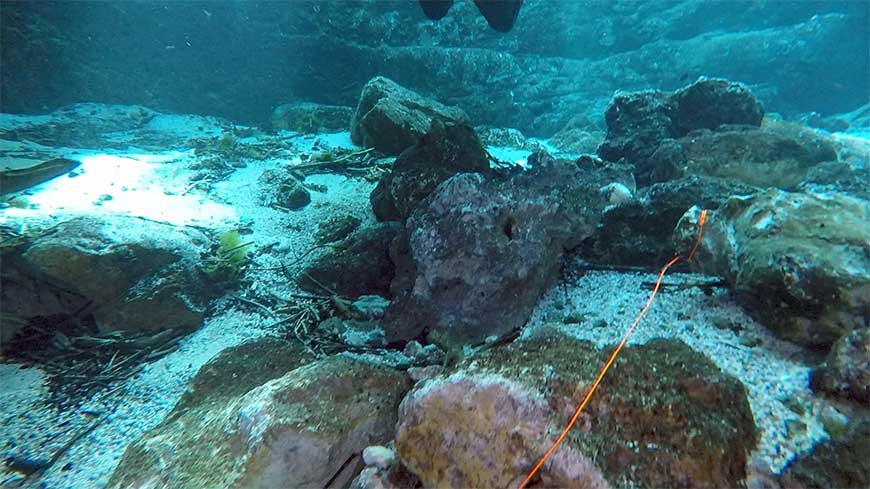
So, if you cave dive somewhere other than in Florida, don’t get all bent out of shape over what you read here. It most likely doesn’t apply to you. (But, then again, it might.)
Also, as this is aimed almost exclusively at a USA audience, I’ll forego my usual practice of using both metric and imperial depth and distance values.
Why tie off in open water?
Depending on who taught you to cave dive, you may already know this.
The rationale for tying off in open water is that, should you reach your primary tie off, only to discover that the previously good visibility somehow dropped to zero while you were in the cave, all you need to do to reach the surface is go straight up.
Seems reasonable, doesn’t it? Unfortunately, the reasoning is flawed.
- When visibility at the cave entrance is good, and there is no expectation of it dropping while you are in the cave, tying off in open water (as opposed to at or just inside the cave entrance) may not only be unnecessary, it can cause some very real problems. These include environmental damage and putting others at risk.
- When visibility at the cave entrance is poor (or nonexistent) — or there is a risk of it becoming so during the dive — simply tying off at the bottom of the open-water basin may not be adequate. Having reached the end of your line, you may only think you are going straight up. Instead, you may find yourself trapped under a log or overhanging ledge. You may even accidentally swim back into the cave — only now you won’t have a guideline to get you back out again. Now if you are saying, “That can’t possibly happen,” you most likely haven’t found yourself in zero viz with nothing to hold on to. The degree of disorientation can be staggering. It’s why pilots in bad weather have been known to ignore their instruments and fly their planes staight into the ground.
Under these circumstances, simply tying off at the bottom of the open-water basin just isn’t enough.
When there is a very real risk of losing visibility in the open-water basin (or there just wasn’t any visibility to start), the only way to ensure you get back to the surface is to tie off at the surface.
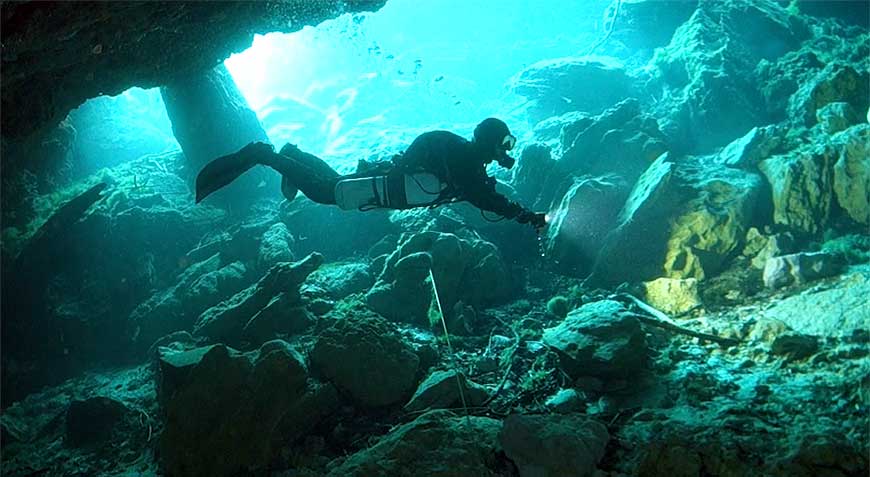
Let’s look at both these situations in greater detail, starting with when there is a very real risk of poor or zero visibility at the cave entrance.
“What happened to the viz?”
How often do north-central Florida cave divers enter an underwater cave in good visibility only to find that, without warning, it has been reduced to zero or near-zero upon their return? At our most frequently used dive sites? Never. There is always some sort of indication ahead of time that this is a possibility.
Let’s take a look at the seven most popular cave diving sites in this part of the state and see why a sudden loss of visibility at the cave entrance should not come as a surprise.
Madison Blue
“First to flood, first to clear.” Because the Withlacoochee River basin is so narrow, and so steep, water levels can rise and fall rapidly. This is why a situation in which a cave entrance could go from “crystal clear” to “black and siphoning” over the course of a single dive has a greater possibility of happening at Madison Blue than it does elsewhere. And it did happen to someone recently.
As the story goes, a couple entered the cave at Madison when the basin was crystal clear. When they returned to the entrance, they were greeted by a wall of black water and zero visibility in the basin. Although this did not prevent them from exiting the cave, they had made the mistake of not clipping their deco bottles off to the line. As a result, they had to run search patterns in zero viz to find the bottles.
Sounds pretty scary, doesn’t it? But then, as Paul Harvey used to say, “…there’s the rest of the story.”
- The couple had heard from several people that the river was rising rapidly.
- At the time they entered, the river had nearly reached the level of the rocks that normally form a small waterfall or rapids at the edge of the basin.
In other words, the fact the basin flooded while they were in the cave should have come as no surprise. They were just lucky the tannic had not yet started siphoning into the cave itself.
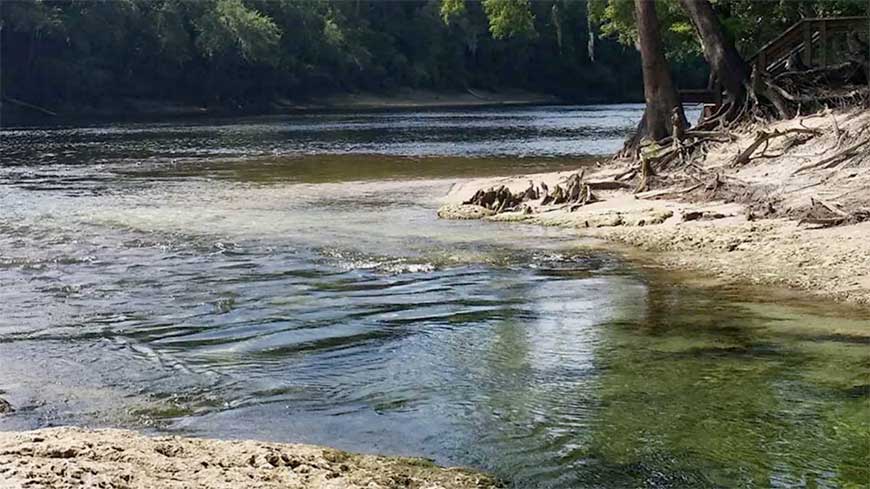
So, if you have any concerns about Madison Blue flooding while you are inside, just look at the river. If the water is rising and the tannic is approaching the rocks, you do not want to dive. Period.
Peacock I and III
Generally speaking, Peacock I and III do not go under until the river water backs all the way up Peacock Slough and begins cascading into the Peacock III basin. This is a fascinating sight if you are lucky enough to catch it. Before this happens, however, there will be other warnings.
- To start, black water will begin collecting in the Dark Water Tunnel and other low-lying areas of the cave.
- As The End approaches, columns of tannic water typically begin to shoot up in plumes in the Peacock I cavern.
So, again, no one can claim a loss of visibility at the entrance comes as any surprise.
A greater concern is the summertime algae bloom that happens at both Peacock I and Orange Grove Sink. This, too, has the potential to reduce visibility to just a couple of feet. Making matters worse is the abundance of loose algae that collects at the Peacock I entrance. This can be sucked into the cave entrance by passing divers, further reducing visibility.
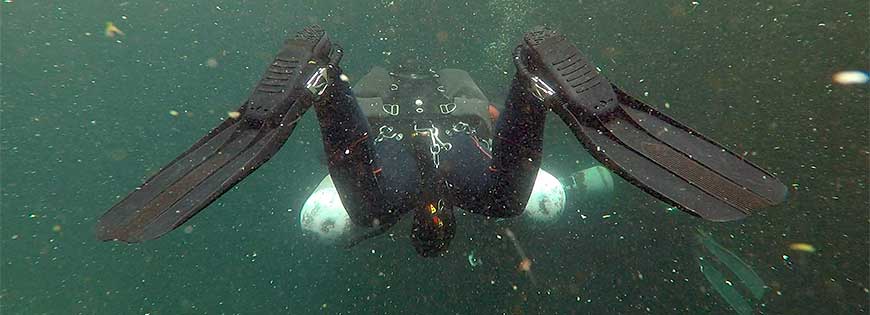
Nevertheless, algae blooms take a week or more to form. It’s not something that will nail you without warning.
Cow Spring
Cow Spring has a slough that runs just a few hundred yards to the Suwannee River. However, before tannic water from the river backs up the slough and begins flooding the basin, river water will most likely begin entering the system through its connection to Running Spring. Thus, you may be more likely to encounter tannic water in the cave before you see it at the entrance. Regardless, this is not a time to be entering Cow.
Little River
Some divers will only dive Little River when the basin is clear. Others feel comfortable passing through a layer of tannic water overhead, as long as they encounter clear water by the time they get to the stake. Experience shows that doing so may carry little risk.
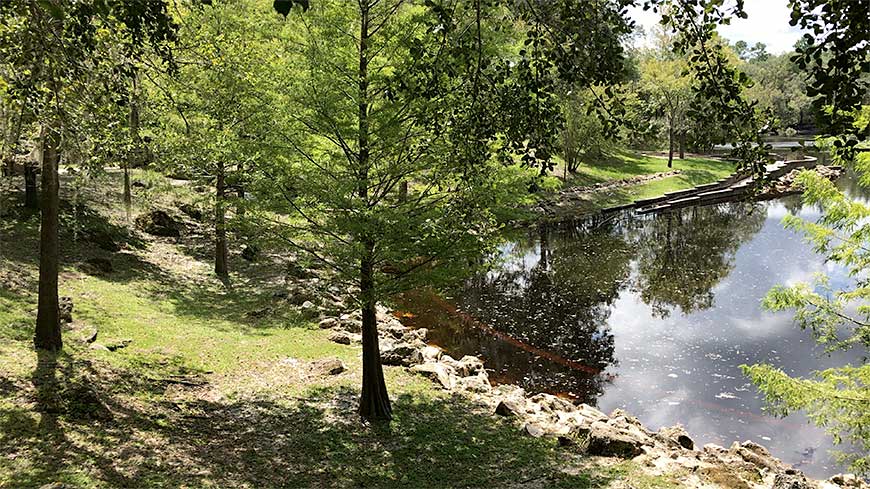
There is a limit, though. One story tells how two divers only found clear water near the start of the gold line. Nevertheless, they decided to proceed with their dive. On their way out, they ran into a wall of incoming tannic water just downstream of the Merry-Go-Round/Serpentine split. They ended up exiting over 800 feet of cave in touch-contact, while fighting an increasingly strong, incoming current.
What is important to understand is that Little River’s entrance does not go from crystal-clear to siphoning in the time it takes to make a single dive. In general, the process takes several days or more.
Devil’s Eye and Ear
I personally have been inside what is normally the cavern zone in Devil’s Ear and seen the entrance blocked by a solid wall of tannic water. Not that it matters. Long before conditions get to this point, the Ginnie staff installs the temporary dam blocking access from Devil’s Eye to the river. The water in the Eye’s basin may get a slight greenish tinge at this point, but remains largely clear.
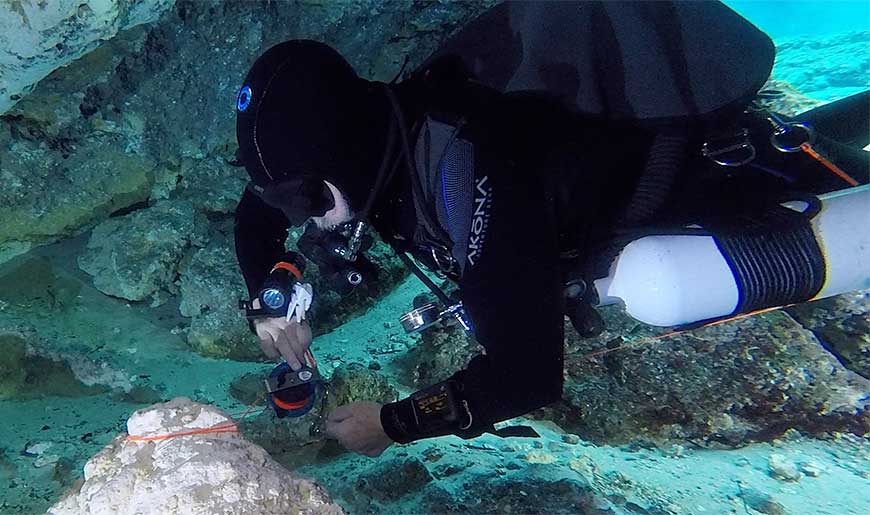
By the time the entrance to Devil’s Eye goes dark, water levels will have risen to the point where you can’t dive anyway, because you will be unable to drive to the parking area at Little Devil. I have yet to talk to anyone who has successfully ventured into the cave at this point.
So again, you are extremely unlikely to enter Devil’s Eye in clear water, only to find zero viz when exiting.
Manatee
Manatee always seems to be the one system that remains clear when all other popular cave diving sites flood. In fact, this is usually when conditions at Manatee are best. This is because the decrease in flow also causes an increase in visibility due to lack of turbidity.
This is not to say that Manatee can’t flood. However, before it does, park officials generally cut off access to the water. The reason they cite for doing so is often an overabundance of visiting alligators.
So what does this mean?
At least as far as the most popular north-central cave diving sites are concerned, it’s unreasonable to base procedures on the assumption that divers could enter a cave when the basin was clear (and there was no inkling of rising water levels in adjacent rivers) only to return to the entrance to discover that everything has gone straight to Hell.
This is not to say this could not happen at some of the less popular sites. But as far as the systems that see the most diver traffic, it’s just not a realistic concern.
So what’s wrong with tying off in open water?
At many sites — and especially those which see little diver traffic or other activity — the answer to this question is, “No.” But at many of the more popular sites, a stubborn insistance on always tying off in open water can cause some very serious problems. And, as these sites become increasingly popular with swimmers, snorkelers, freedivers and open-water divers, the severity of these problems becomes worse.
Here are some specific examples:
Environmental Damage
Rock is more durable than cave line…right? Not really. The limestone that makes up so many of our underwater caves is among the softest and most fragile rock known to man. You can actually saw right through it using cave line. You might go through a couple pieces of line in the process but, while you can get more line, you can’t make more rock. Now consider the following:
- You are at a dive site where there are two choices for making your primary tie off: A rock formation in open water or a log just inside the entrance.
- The log provides a safe, solid and secure tie off that is clearly in sight of the entrance. Additionally, there is no risk that the entrance will be anything but crystal clear for the entire duration of your dive.
- However, you’ve always been told that primary tie offs must be made in open water, so you opt for the rock instead.
- Unnoticed by you, the act of tying off to the rock causes an ever-so-slight amount of damage to the formation — just as it did when countless divers used that rock as a tie off before. And, eventually, there will be no rock to tie off to.
- Ironically, had you tied off to the log instead, there would have been no appreciable environmental damage.
The fact is, running guidelines has the potential to cause considerable damage to caves. We need them for safety; however, when we run them unnecessarily, we can cause unwarranted damage.
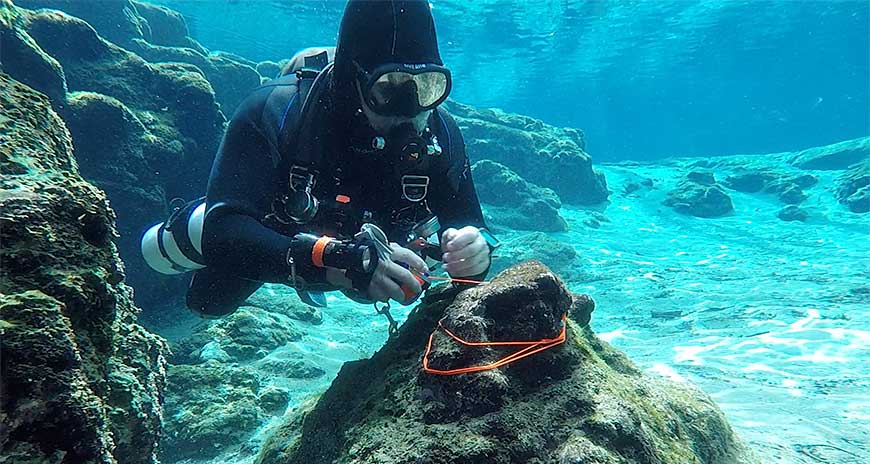
All those upside-down concrete flower pots in Peacock? They are there to help prevent the environmental damage caused by guidelines. Think about that.
Damaged Tie Offs
Of all the environmental damage caused by guidelines, none is potentially more harmful to divers that the loss of critical tie offs. Over the four decades I’ve been cave diving, I’ve watched as popular cave diving sites have gone from having dozens of viable tie offs in open water to having virtually none. They have all been worn away through use.
Any time you tie off to a rock formation in open water when there is a safer, more secure and less environmentally sensitive alternative at or just inside the entrance, you increase the likelihood that a critical tie-off point won’t be there when someone else actually needs it.
Unsafe Tie Offs
Among the criteria for a safe, secure tie off point is that it should be:
- No bigger around than a telephone pole
- Firmly attached to the bottom
- Able to hold the line securely
How often in recent years have you seen someone make a “tie off” consisting of loose wraps around an easily moved rock — just so that he could say that he did so in open water? Hardly what you could call safe or secure — but necessitated by the fact the more-secure tie offs that once populated the basin have long since been worn away.
Then there is what I frequently see at the bottom of the Peacock I basin. People will make the most tenuous tie offs to pieces of rock that can just barely hold the line — all so that they can pat themselves on the back and say that they ran a continuous guideline to a permanent line that starts barely an arm span inside the cave.
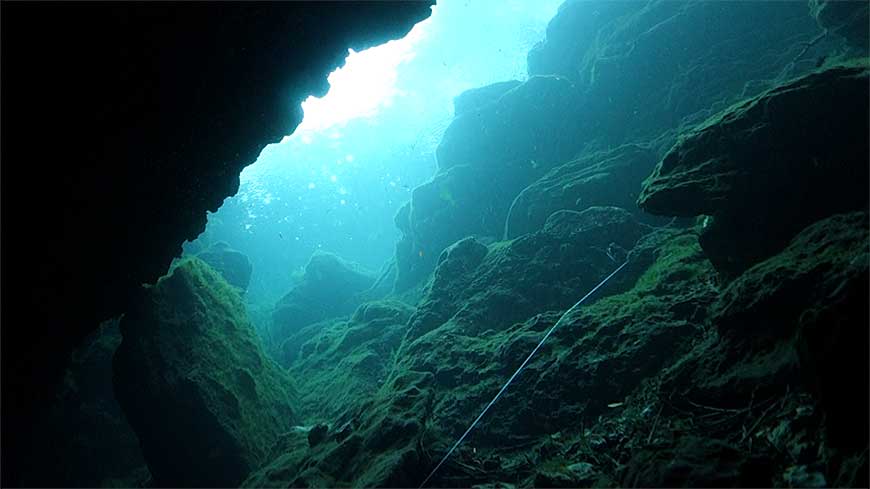
What most divers don’t realize is that the reason the permanent guideline begins where it does is that the landowner, the state of Florida, doesn’t want divers running reels at the Peacock I entrance unless absolutely necessary. This policy was put in place to cut down on the amount of damage guidelines can cause. Seriously, this is part of the management plan for the cave, along with all those upside-down flower pots.
In the years before the gold line started where it does now, there was a large log that ran crosswise to the entrance, some 15 feet inside the cave — ten feet further in than where the gold line starts now. This is where everyone used to make their primary tie offs. There was never an issue with this, and no one considered it unsafe.
But now we have a whole generation of divers who have been taught that they must run a reel from open water, even if it is only the six feet to the gold line. This is not only nuts, but it is in direct violation of the state park management plan.
Okay, sometimes the visibility in the basin at Peacock is so poor, you don’t want to rely on the gold line alone to get you out of the cave. But, when that happens, you do not want to be tying off at the bottom of the basin. Not unless you think it would be fun to accidentally swim back into the cave after pulling your reel.
What you need to be doing under those circumstances is tying off at the bottom of the stairs, running your line down across the face of the rock that divides the entrance (to reduce the likelihood of entangling others), then connecting into the gold line. This is how I teach students to run reels at Peacock I — while explaining that they are only to do this when the visbility is poor.
Entanglement Risk
What we are talking about here is not a risk of entangling yourself or your fellow cave divers. Rather, it’s the risk of entangling the general public who frequent the basin at many sites. They don’t know that a guideline — any guideline — presents an entanglement risk. They may not even notice your guideline until it entangles them. This is a risk that is frequently present at sites such as Madison Blue, Little River and Devil’s Eye.
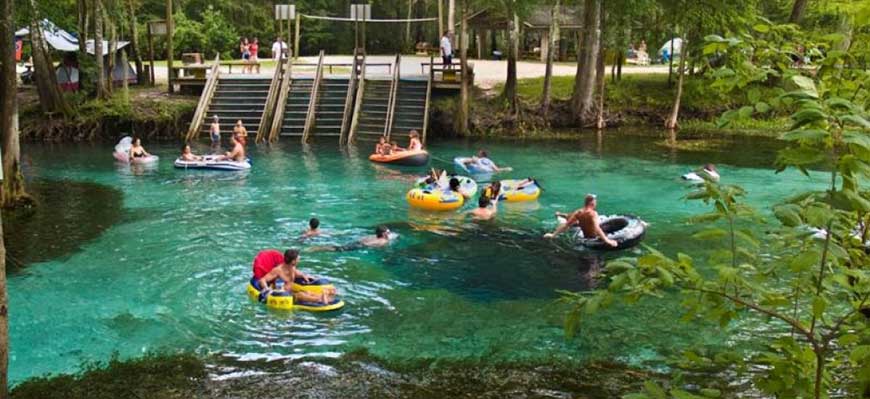
Guideline entanglement presents a particularly serious risk to swimmers, snorkelers and freedivers — anyone who is not on scuba. A person in this situation could easily panic and drown before getting free, and you would not be able to help them, as you would be in the cave. You would, however, be the person the survivors would most likely sue for creating the hazard that killed their loved one.
So, if you tie off in open water at a site frequented by anyone other than cave divers, you could conceivably put innocent people at risk by tying off in open water. Tying off at or just inside the entrance reduces this risk.
Enticement of the Unqualified
Let’s face it: Some unqualified scuba and free divers wil swim into an underwater cave no matter what you do. You may not be able to stop them; however, you can at least discourage bad behavior. When you tie off in plain sight, you:
- Advertise the fact there is a cave entrance nearby and point directly to it.
- Create a false sense of security among the unqualified — someone who might not have entered the cave were there no apparent guideline, but who now feels it is okay to do so because there is a guideline in place.
This has always been a problem with sport divers. Now, with the surge in popularity of freediving, we’ve seen an increase in the number of people who think it’s cool to freedive into caves. It isn’t. In fact, it is among the most dangerous things a person can do — especially when there is a poorly-laid guideline place that might ensnare and entangle a freediver.
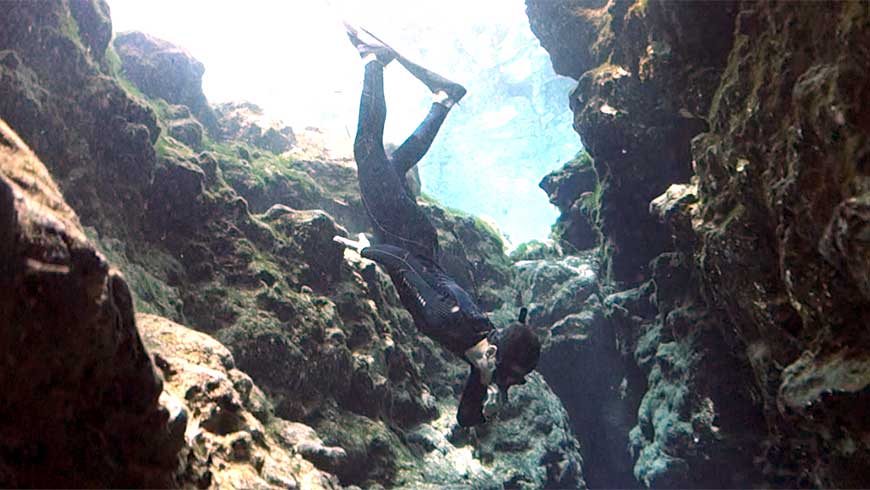
This is another reason why it may be better to make your primary tie off at or just inside the entrance. Doing so will make your guideline less apparent to casual observers.
Restricted, High-Flow Entrances
Let’s talk specifically about Devil’s Ear. Unlike sites such as Madison, Little River and Peacock, where two teams can enter and exit simultaneously, at Devil’s Ear only one team can enter or exit at a time.
Have you ever run into a situation where you and your team mates were preparing to exit Devil’s Ear, only to find your path blocked by another team who was struggling to run a reel in from open water? As the exiting team, you are supposed to have the right of way. Yet expecting the incoming team to get out of your way is unrealistic at this point. So you sit and wait while the incoming team finally finishes running their reel. Meanwhile, your deco requirements increase while your breathing gas continues to diminish. Fun.
An even more likely situation is that you return to Devil’s Ear to find that no one is trying to enter while you are exiting. However, a previous team’s poorly laid guideline poses a severe entanglement hazard. Perhaps it wasn’t that way when the other team first installed it, but it has since come loose and is now flopping around loose in the breeze, waiting to snare you.
These are just two examples of what can happen if people feel a compulsion to “tie off in open water” when doing so isn’t actually necessary. Fortunately, there is a safer alternative.
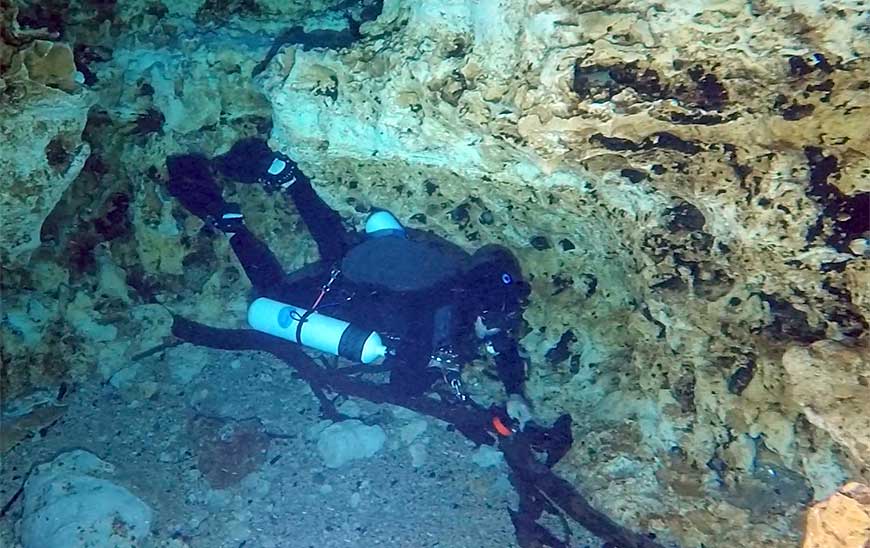
The next time you enter Devil’s Ear, look immediately to your left. You will see that there is an area just inside the entrance, in front of the large rock shelf. This area is only a few feet from the exit, yet almost completely out of the flow. And, unlike the open-water basin, which once had several tie-off points which have since worn away, this area still has a few potential tie-off points remaining.
This is a vastly better place to be making primary tie offs.
- There is little flow to fight.
- You will not be blocking another team who is attempting to exit.
- There is less likelihood of your line coming loose and posing an entanglement hazard to others. (It also poses less risk — and less of an enticement — to any open-water divers foolish enough to try entering.)
And let’s face it: Given good visibility and high flow, there is simply no way you are getting back to this point and not getting out of the cave. After all, were the visibility poor, you would be going in and out the Eye, not the Ear.
Crossed Lines
This can happen at any number of places, but Little River illustrates it best.
What sets Little River apart from other cave diving sites is that it is an exception to the rule that teams should never share the same primary tie off. Years ago, someone drove a steel rod into the rock floor, just behind a large boulder at the entrance. A protocol was quickly established so that multiple teams could share this one tie-off point.
Basically, the first team in ties off near the top of the stake; subsequent teams tie off just below the lines of previous teams. The idea is that the first team in will also be the first team out, and can more easily pull their reel if subsequent teams have tied off below them.
Using the stake provides a number of benefits.
- It compensates for the lack of natural tie-off points in the basin.
- It hides the fact there are lines running into the cave from casual passers-by.
- It prevents there from being lines running out into the basin which could entangle the swimmers and snorkelers who are frequently present at this site.
Hopefully, none of this is news to you, and an explanation of this protocol was part of your original Cave Diver training. If it wasn’t, your instructor did you a disservice.
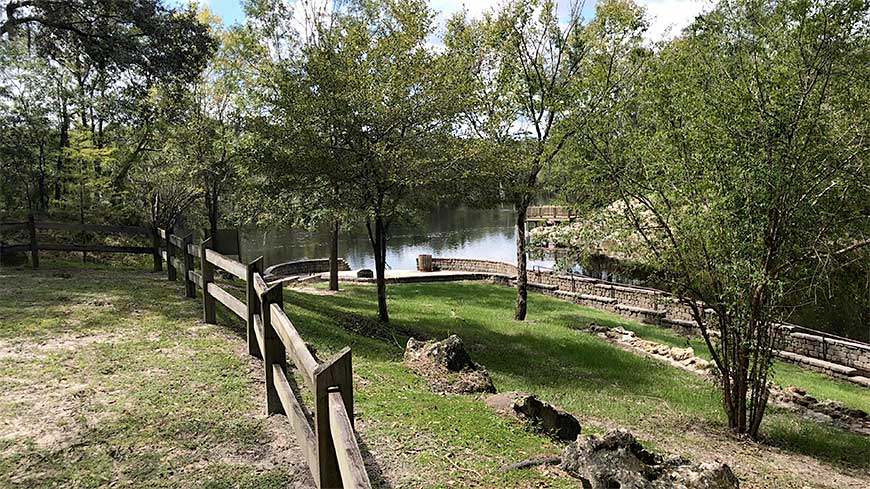
So what can happen when divers choose to ignore the protocol and make a tie off in open water? Here is an example:
- For whatever reason, a team entering Little River decides to ignore the stake and make their tie off in the basin. (Well, there are logs — although their size, shape and positioning is seldom ideal, and they tend to move around a lot.)
- The team manages to make a tie off in open water and enters the cave running their guideline along the right wall.
- Upon coming abreast of the stake, the team discovers that two other teams have entered the cave before them. One team’s line runs up the middle of the passageway; the other along the right wall.
- At this point the new team realizes that they will need to run their line along the left wall to avoid the other guidelines. However, to do so, they are going to have to run their guideline across the width of the cave, increasing the risk of entangling others and possibly crossing other guidelines.
Of course, this problem could have been easily avoided had the new team simply followed the established protocol and shared the stake with the other teams. It also brings up another point.
Never make a tie off in open water and enter a cave without first sticking your head inside and seeing whether other teams have run lines before you and where those guidelines are.
There is no Boogey Man
By now you should realize that where you should make your primary tie off depends entirely on conditions.
- If there is poor visibility at the entrance — or there is any chance that the visibility could become poor while you are in the cave — tying off at the bottom of an open-water basin may not provide an adequate margin of safety. If you want to ensure that you can return to the surface, you need to tie off at the surface.
- If there is daylight, the visibility at the cave entrance is good, and there is no real possibility of the visibility dropping over the course of the dive, tying off in open water can cause some very real problems — without contributing anything meaningful to safety.
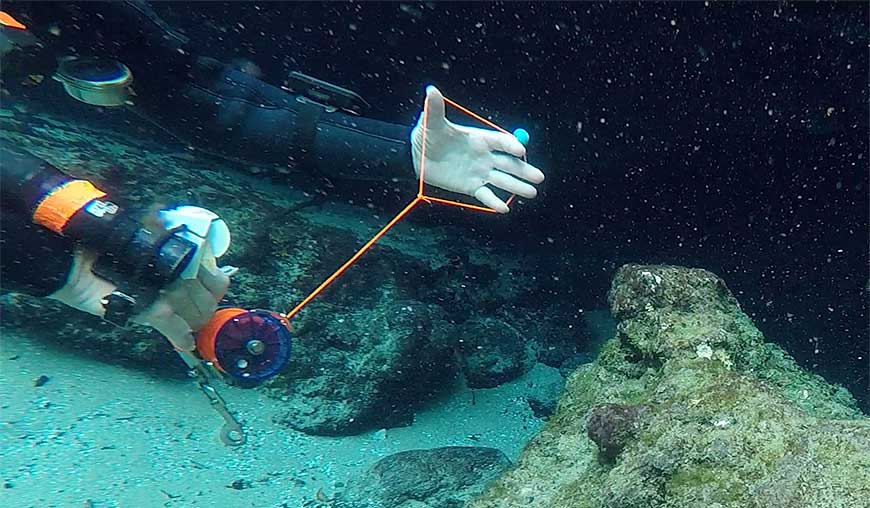
Before making a primary tie off in open water, at the cave entrance or just inside the entrance, there are a number of questions you need to answer. These include:
- Is the tie off point you plan to use safe and secure? Can you be confident that it won’t come undone while you are in the cave? Making a tie off at a certain point simply because it is where you would like it to be won’t help you if that tie off comes loose later.
- Will your guideline pose a risk of entanglement, not only to you and fellow cave divers, but to swimmers, snorkelers and others who may be using the site?
- Will your guideline be visible from outside the entrance and, as such, serve as an enticement to freedivers and open-water divers who want to see where it goes?
The spectre of an open-water basin that goes from crystal clear to black and tannic over the course of a dive is like the Boogey Man: A tale created to scare people that has no basis in fact. The stake at Little River, the log which everyone used to use at Peacock, the tip of the log at Devil’s Eye; these all clearly establish that you can make a tie off at or just inside the cave entrance and not be at appreciable risk.
Dive Rite’s Lamar Hires has the dubious distinction of having worked more body recoveries than any of us. I’ve asked him on more than one occasion if there has ever been a situation at one of our popular cave sites, in daylight and good visibility, where a team made it to the end of a guideline that was close to and in clear site of the exit — yet was somehow unable to make it out of the cave? You already know the answer to this question. It’s no.
“But standards say…”
If you teach cave diving, this issue not only becomes a matter of what you do, but what you teach students to do.
- If you teach through agencies such as NSS-CDS or IANTD, you are in the clear. Their standards only state that you need a continuous guideline “to a safe exit.” Now, I’d hate to have to define or defend what a “safe exit” is in a court of law, but I feel the intention is good.
- I’ve not read NACD’s or GUE’s latest standards, but my understanding is that they insist that all primary tie offs must be made in open water. And if doing so results in unnecessary environmental damage, the loss of critical tie-off points — or the entanglement and death of an innocent party — well…I guess that’s just too damn bad.
So what about the agencies I haven’t mentioned? The one I’m most familiar with has standards which state that instructors must “maintain a continuous guideline to open water.” Note that the standard says to open water, not out into open water.
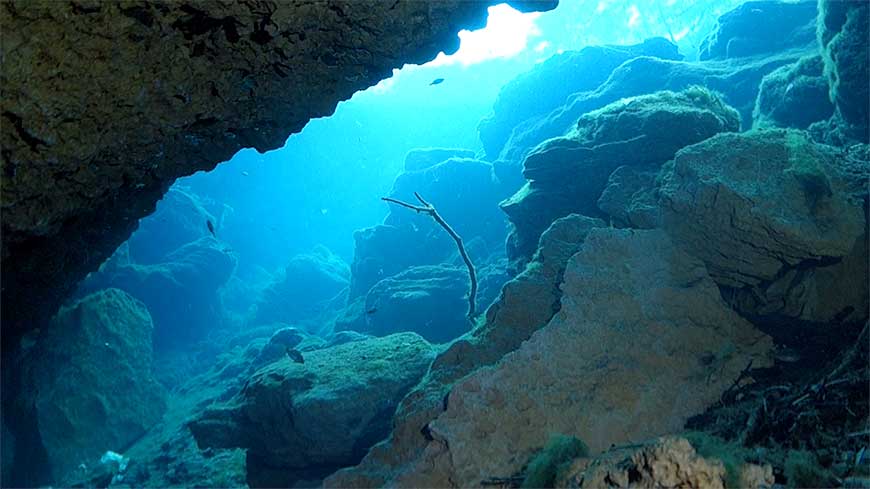
Some instructors interpret this as meaning primary tie offs must be made outside the cave entrance. I don’t…and here is why. Think of how we define the difference between the two types of permanent guidelines:
- Offshoot lines lead to other parts of the cave or other guidelines.
- Main lines (i.e., gold lines) lead to open water (as opposed to anywhere else in the cave).
It seems to me that any guideline that will take students to a clearly visible exit (as opposed to elsewhere in the cave) meets the criteria of to open water.
The bottom line is that nothing in cave diving is ever black and white. We can have safer cave diving — but never “safe” cave diving. Even following Sheck Exley’s Five Rules will not make you bulletproof. But blindly following rules that defy common sense? As you’ve seen, this can actually decrease overall safety rather than increase it.
